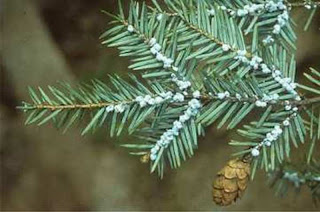And officials are hoping anyone who spots these unwanted guests snaps a photo and sends it in.
At the top of the wanted list are the Asian longhorned beetle and the emerald ash borer.
Neither destructive insect has been found in New Hampshire, but forestry and environmental officials are on the lookout for a potential invasion — and they want residents to do the same.
There’s a website, nhbugs.org, where residents can upload photos of suspicious insects. Experts will identify the bug in question and post the more interesting photos on the website. There already are dozens of photos up, many of an Asian longhorned beetle lookalike — the white spotted sawyer beetle, harmless and present throughout the Granite State.
The Asian longhorned beetle, commonly known as ALB, was found in Worcester, Mass., in 2008 and in Boston in 2010. It has the potential to decimate hardwood forests and maple trees are high on the list of susceptible trees.
The insect could cost the country 30 percent of its hardwood trees — some 1.2 billion trees, according to the USDA’s Animal and Plant Health Inspection Service.
New Hampshire has 2.5 million acres of northern hardwoods — birch, beech and maple trees, according to Fred Borman, a forestry educator with the University of New Hampshire Cooperative Extension office in Brentwood.
The emerald ash borer is equally unwelcome. It is only interested in ash trees and has killed millions of those trees in the Midwest.
There was a report earlier this year of a small population of emerald ash borer on the east side of the Hudson River in New York, Borman said.
“It’s a matter of time. The emerald ash borer has a much faster spread rate than ALB,” he said. “Adult females tend to stay on same tree until the tree dies, about five to seven years. Emerald ash borers, both male and female, are very food fliers and they will travel up to 2,000 feet to find a new host. ALB are lay fliers.”
There’s a third insect that concerns forestry experts — the hemlock woolly adelgid, but it’s already here.
“We’re at a point where we’re monitoring it; we can’t control it,” Borman said. “We hope for a really cold January.”
August is a particularly active time for ALB and they might be found in an unlikely spot — swimming pool filters.
After ALB was discovered in Worcester, a public swimming pool worker told experts he had been collecting the nasty beetle for years in the pool filters.
Education and awareness are key to combatting these unwanted insects, according to Karen Bennett, a forestry specialist with UNH Cooperative Extension.
“Look at your trees all the time, year round. Be skeptical, if the tree doesn’t look good, ask someone,” Bennett said. “We really try, through the website, to make it easy for people. Take pictures of suspected .insects. We have an entomologist who looks at everything and gets back to folks.”
Adult insects would be active now through the end of August, she said, and if they’re here, they’d be flying.
“I have reason no reason to think they are, and no reason to think they aren’t,” Bennett said. “We really don’t know and that’s part of the frustrating thing.”
But experts do know the hemlock woolly adelgid is here and spreading through Southern New Hampshire.
“Extreme cold keeps them under control; it definitely depresses the population,” Bennett said. “This past winter was anything but.”
Asked to rank the unwanted insects, Bennett said, “They’re all pretty bad, as far as I’m concerned.”
“Anybody interested in white ash would rank emerald ash borer as the worst threat because you have dead trees in a short period of time,” she said. “But, in the overall scheme of things, ash is a pretty small percentage of our forest. I personally think the emerald ash borer is potentially worse than hemlock woolly adelgid or ALB.”
But all non-native insects are cause for grave concern, she said, because they don’t have natural predators.
So, experts are counting on the public to remain vigilant and help them keep tabs on the state’s insect population.
What to look for:
 |
| Asian longhorned beetle: It's large, between 0.75 and 1.25 inches long. It has very long black and white antennae. The beetle's body is glossy black with irregular white spots. |
 |
| Emerald ash borer: The metallic green adult beetle is about an inch long. Its body is bullet shaped. |

No comments:
Post a Comment